
University of Leuven
An image of a right knee after a full dissection of the anterolateral ligament, or ALL.
The previously unknown piece of tissue, recently described in the journal of Anatomy, was first mentioned by French surgeon Paul Segond in 1879.
According to the study, Segond noted the existence of a "pearly, resistant, fibrous brand," but until now, no clear anatomical description had been provided.
Steven Claes and Johan Bellemans from the University of Leuven decided to look into this theory as part of their research on ACL injuries, one of the most common knee injuries to affect athletes.
The doctors dissected 41 knees from human cadavers and found an ALL in all but one of the knees.
Given its structure and location in the knee, the researchers think that the ALL affects the the pivot shift of the knee - a condition in which the knee gives out during physical activity even after surgery to repair an ACL tear. This could mean that pivot shift is actually caused by an injury in the ALL.
More research is needed to confirm this hypothesis, but the finding could help for future treatment of ACL injuries.